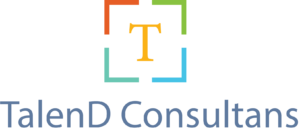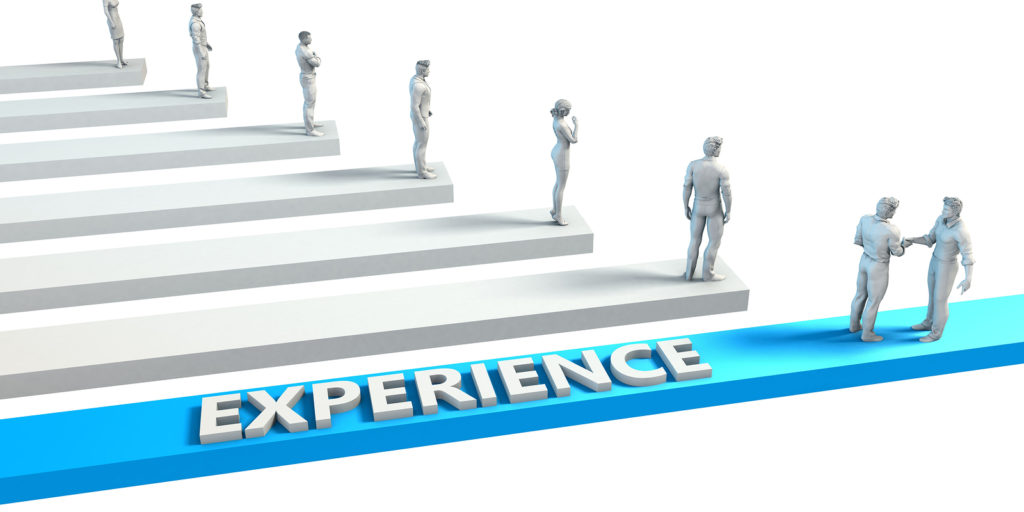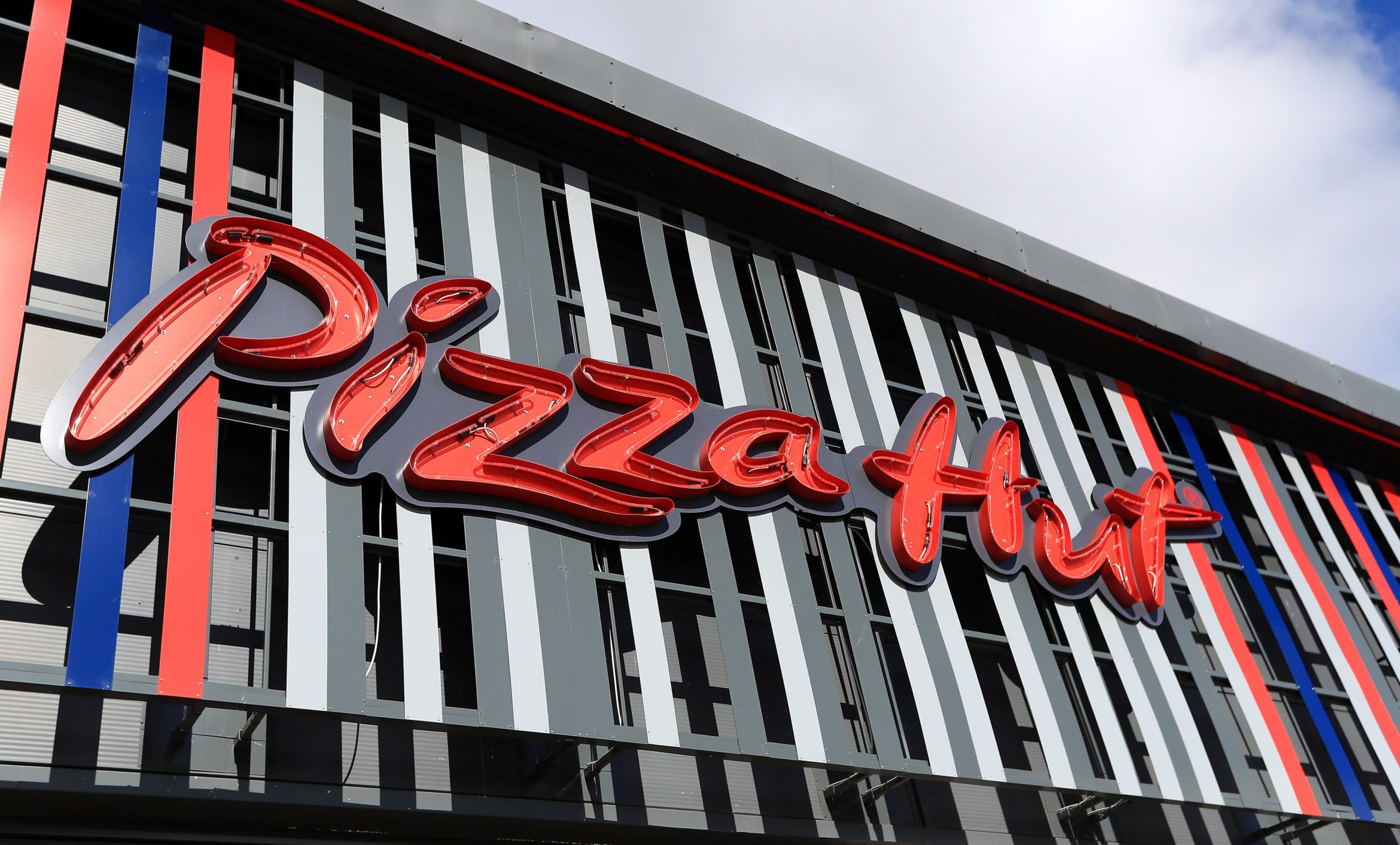Have you noticed how many interesting new HR software companies we have? There’s a reason. The craze for “integrated talent management systems” is ending, now replaced by a market for “talent experience” solutions.
In this article I’m going to discuss the history of “integrated talent management” and explain why it feels so dated. Then I will explain why the concept of “talent experience” has taken over and how it is transforming the HR technology market.
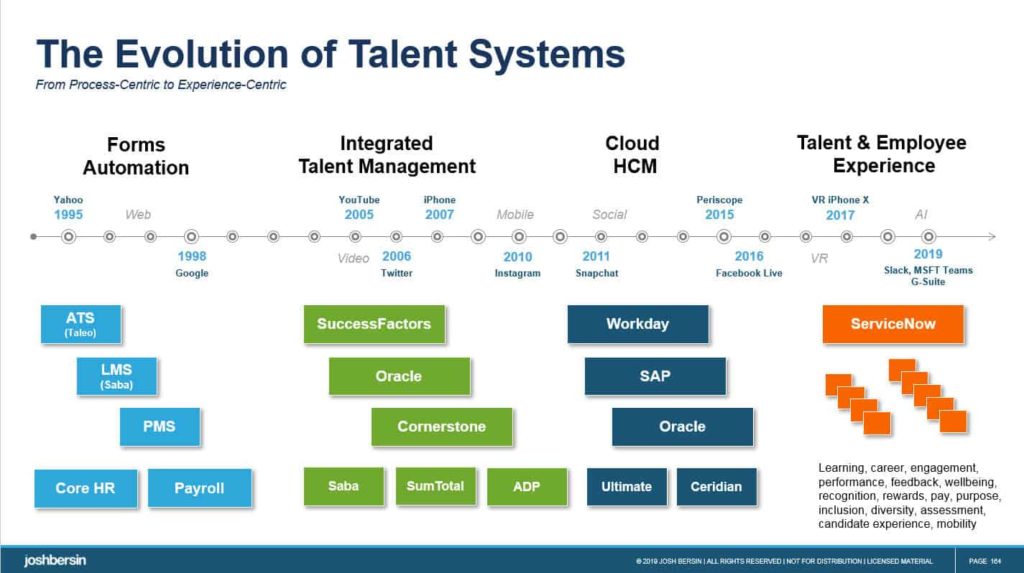
The History of Integrated Talent Management
HR technology follows general tech and social trends. In the early 2000s companies started to automate the forms we used in HR. Technologies like applicant tracking systems (ATS), learning management systems (LMS), and performance management systems (PMS) were growing explosively, giving birth to a market of these “talent management” tools.
As more and more of these tools became available, companies started to realize they needed a more integrated approach. So around 2006 and 2007 the concept of “integrated talent management” took off.
Here is the slide we used from 2006.
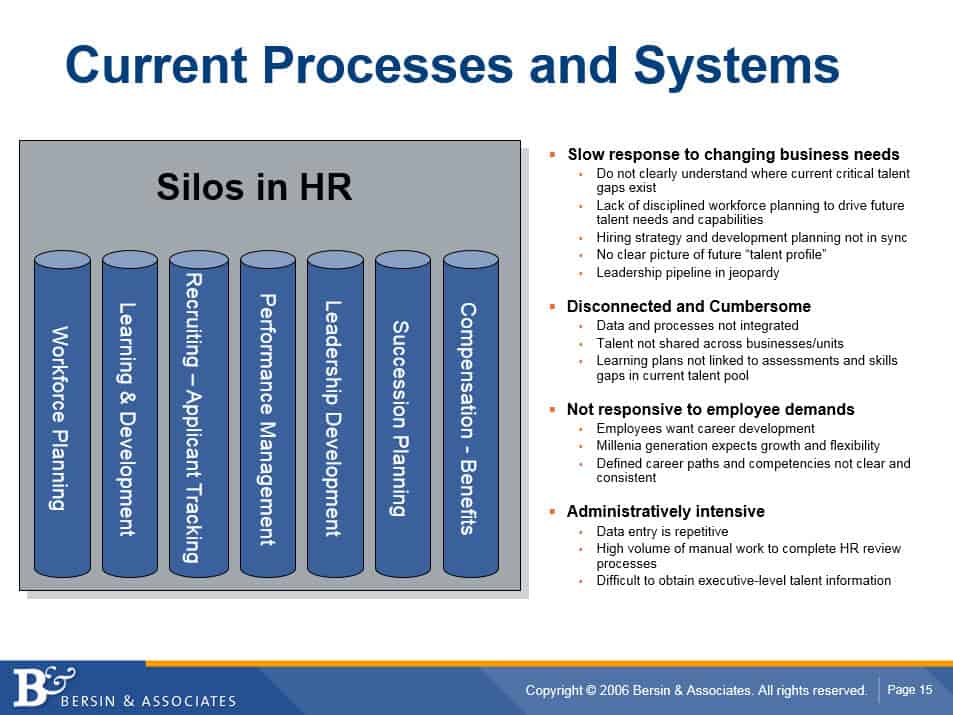
Companies bought this vision: one of the world’s largest defense and aerospace firms decided to build competency-based job descriptions for every job in the company. Hundreds of companies went down this path.
The idea was to integrate talent practices around competencies. If we built an “integrated talent system” based on job and competency models, we could better select the right people, set goals for reward and promotion, create careers based on competency levels, design consistent solutions for succession management, pay for performance, and … well you know the rest.
It was a lovely vision, and the word “integrated” was at its core … and there was often a new VP of Talent to manage all this.
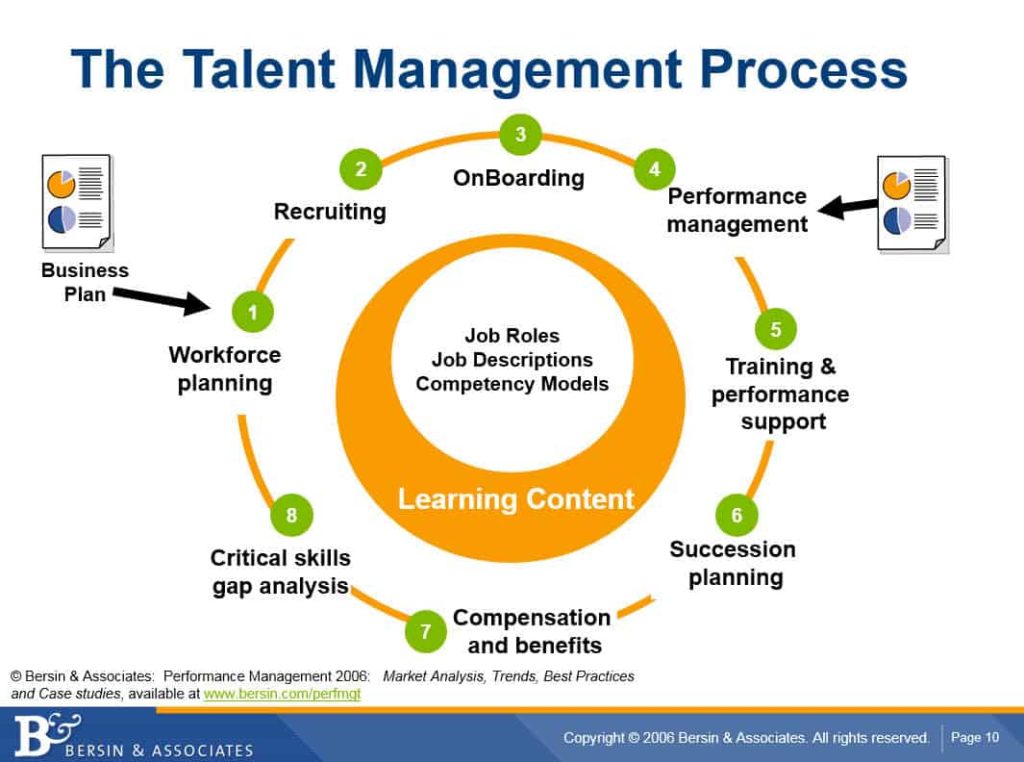
Software vendors started building integrated suites. We had a decade of acquisitions, and companies like Cornerstone, SuccessFactors, Taleo, Saba, Lumesse, Halogen, ADP, Ceridian, and then Oracle, SAP, and later Workday all jumped on board. Many of the standalone applicant tracking, learning management, and performance management software companies went away.
The focus was limited: topics like employee engagement, experience, and diversity were “left on the side.” I remember a talent leader at Clorox asked me (circa 2006) “why isn’t diversity in your talent management model?” I scratched my head and said, “I’m not sure, it probably does belong there.” But it wasn’t a big issue at the time, so we left these features out.
As the market for suites heated up, a frenzy of acquisitions took place (it felt like musical chairs). SuccessFactors acquired Plateau; Taleo acquired Learn.com; SumTotal acquired Mindsolve. Then SAP acquired SuccessFactors, Oracle acquired Taleo, Skillsoft acquired SumTotal, ADP acquired Workscape, Ceridian acquired Dayforce, and all the other vendors were left looking for buyers.
A few vendors, like Cornerstone, Skillsoft, and Saba, were big enough to grow and bought others. Others started to struggle, and many were later acquired at small valuations.
Enter the Cloud and a Massive Recession
Around 2008 the whole market changed. We had a massive recession and the idea of buying expensive HR software to “integrate stuff” was shelved. Companies started to look at “optimization” not “integration,” and we entered a period where we focused on “making these talent practices work better,” and do it at the lowest possible cost.
The technology landscape also radically changed. 2008 was the year the iPhone was introduced, and platforms like Twitter, Facebook, and YouTube took off. So as we were figuring out how to stop spending money and manage HR in a more focused way, the idea of using mobile, video, social media, emerged.
The HR tech industry took a turn. Workday launched the idea of a “born in the cloud” HCM system and changed the market completely. The company showed us a new vision: an integrated cloud-based platform that was cheaper to buy, cheaper to operate, and easier to use. We suddenly wanted “systems of engagement” not “systems of record,” and the older talent management systems looked dated.
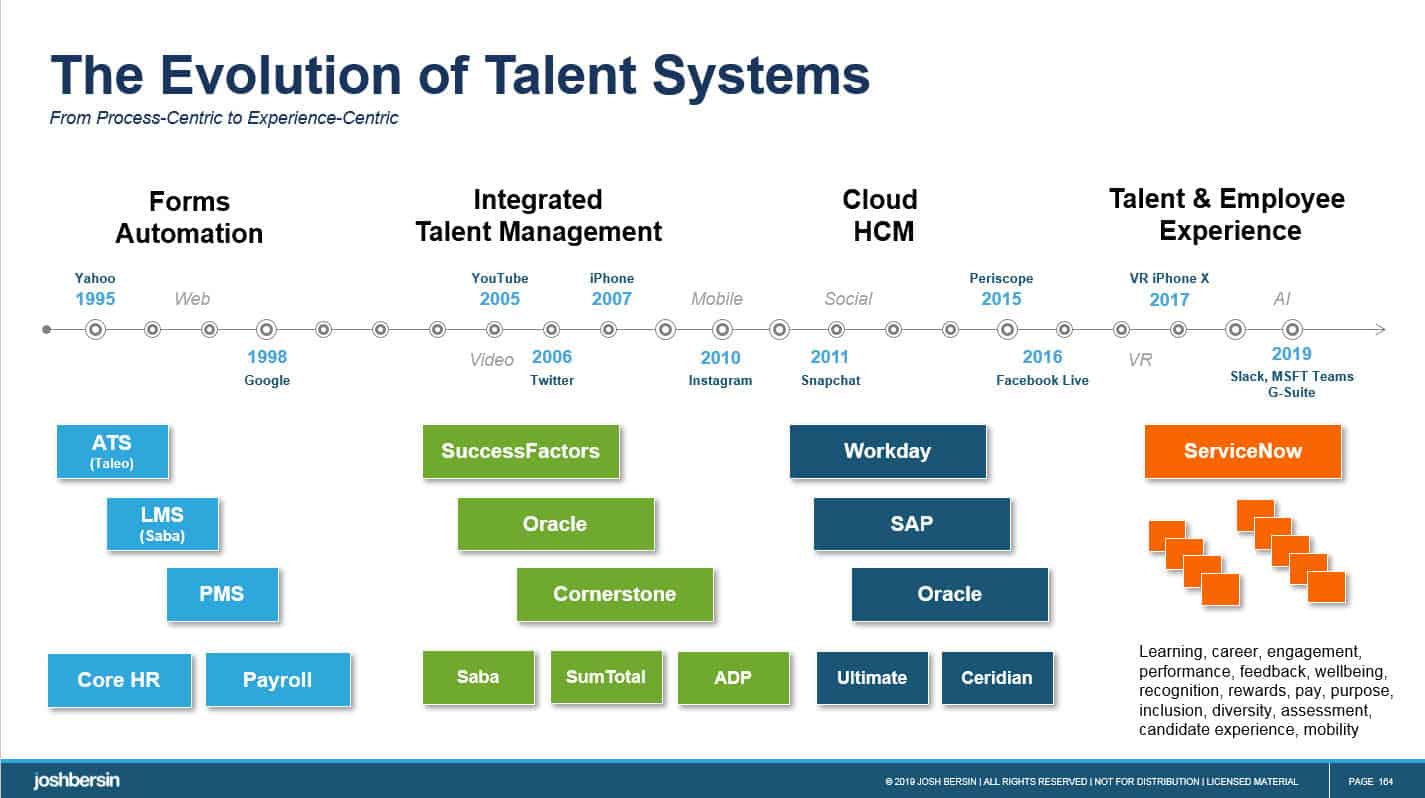 |
While Workday led the charge, vendors like SuccessFactors, Oracle, Cornerstone, and ADP quickly jumped in. Social, mobile, and analytics were the next big thing. We just assumed we could integrate things through the cloud.
Digital Transformation, Leading to The Employee Experience
Somewhere around 2012, businesses started working on “digital transformation,” and CEO’s became focused on digital skills, agile transformation, and new ways of managing jobs and careers. LinkedIn and Indeed and Glassdoor transformed the recruiting market, so HR departments became focused on culture, engagement, and employment brand.
Today, after almost 12 years of economic growth, almost 40% of the workforce is independent and the talent issues are evolved: We must compete to find smart people, create transparency and mobility, develop a growth mindset, and build a culture of trust, inclusion, transparency, and fairness.
And given the level of employee stress and business focus on productivity and wellbeing, we have all become focused on the “employee experience.”
Looking back, we’ve come a long way from “integrated talent management,” which was entirely focused on the needs of HR. Now we are focused on employees, and how we make their work and personal lives better. Hence a focus on “talent experience,” not “talent management.”
The Word Experience: It’s Everywhere
There are many definitions for the word “experience,” but the one that stuck with me is this:
An experience is an encounter. It’s an event that you come in contact with, react to, face up to, and remember.
What has your experience with HR been like? Usually not so hot. Well now it’s HR’s job to fix all this, and problems like integrated talent management just have to take place behind the scenes.
Does all this make sense? You bet it does.
Look at our personal lives. Young people now prefer “experiences” to “belongings,” and we are all so busy, stressed out, and overwhelmed by emails that we just don’t have time for “experiences” we don’t like. How many times have you downloaded an app, clicked on it, and then deleted it in ten seconds if it was too hard to use. I do it a lot!
Such high expectations have arrived at work: if employees don’t find the work experience compelling, they complain, gripe, post something online, or just quit. We have to upgrade all of HR (software and practices) so it’s useful, productive, and meaningful. Which is why I’ve written so much about the shift from “systems of engagement” to “systems of productivity.” If this software doesn’t make my life better, I’m not using it!
It’s difficult to design “experience software.” Just as Learning Experience Platformvendors have disrupted the LMS market, so the Talent Experience Vendors will disrupt the talent management market.
And these new vendors are taking over. The iconic vendors in this phase are not Workday, Oracle and SAP (who are all trying), but new rocket-ship vendors like ServiceNow and hundreds of startups, covering every topic from on-demand learning to well-being, feedback, agile goal management, and AI-based recruiting. I think SAP’s $8 Billion acquisition of Qualtrics sets the pace of what’s to come, and I would not be surprised to see other big surprises come next.
Talent Experience Systems
What is this new marketplace all about? It’s a focus on making employee’s work, life, and careers better – not just automating HR. Consider how the world of talent management has changed.
- People don’t work for one company their whole career: they move, transition, and work part-time. Two-thirds of Xennials (Gen-z) now do side-hustles.
- Employees don’t want to wait for compliance training or manager-driven learning, they want to learn all the time. And the want access and control to the topics they learn.
- Professionals don’t want to wait for their manager to give them a promotion, they want to try new gigs and projects on a regular basis.
- People work in teams not hierarchies, so they want goals that are simple, transparent, and easy to update.
- People don’t just want vacation policies, they want wellbeing programs, mindfulness, and help with their personal and financial fitness.
- When we decide who to promote, the 9-box grid and talent reviews barely work. We want the systems to tell us who has the best network and who is most likely to succeed. And then we want to give that person an opportunity, even if they’re younger than the boss.
- We can’t keep up with job descriptions and competencies any more, because jobs are changing faster than we can see. We want systems and data to tell us what capabilities most needed, and then AI-based tools are to tell people how to perform.
And the whole idea of job descriptions and competency models is under attack. Do we really need them when the work we do keeps changing? HP just told us they did away with job titles, (simplifying the number of levels in the company from over 60 to around 14), so people no longer mind changing roles as the company needs.
And we must focus on simplicity and productivity. The pace of business has become breathtaking. Cities are crowded with workers; commute times are long; airplanes are filled with business travelers; and it’s common to travel across many time zones just to meet with clients. We’re all having the time of our lives in this booming economy, but its stressful, competitive, and salaries are barely keeping up.
In other words, the issues companies face are very different than they were a decade ago: we want the “experience at work” to thrive.
| The 2000s | Today | |
| Our Focus | Integrated Talent Management | A Meaningful Work Experience |
| Our Goal | Integrated HR transactions | Positive employee experiences |
| Our Systems | Processes integrated into one platform | Tools and apps focused on employee journeys |
| Our Platforms | ATS, LMS, TMS | Dozens of cloud-based tools and platforms |
| Integration | Integrated around competencies and job models | Integrated around individual people, roles, and needs |
| TechDesign Practices | Multi-page portals with integrated back end data | Simple intuitive experiences with seamless back end integration |
| Underlying Technology | Integrated data models and transactions | Microservices, cloud to cloud interfaces, chatbots and AI-based services |
| OurDesign Point | Business Processes | Employee Moments |
The Radical Change in the Tech Market
As I’ve watched the HR tech market explode (read my report on the 2019-2020 market here), the changes have been pretty radical.
- We thought the cloud-based HCM system was a panacea, we now realize it’s just a platform.
- We used to want fewer HR systems: we now have more… but they are far better integrated.
- We used to sacrifice best of breed for a suite: today we search for best of breed and focus on the experience.
- We used to look for a big, stable vendor. Now we look for a stable core platform and buy from many innovative vendors.
- We used to integrate systems on the back end. Today we integrate them on the front end (from the user experience).
And with all this change, vendors that focus on integrated suites have fallen behind. I can’t tell you how many companies tell me their LMS just doesn’t drive much value anymore. We need a new breed of HR technology to help us make work better. (Here are a few examples.)
| Talent Categories | Typical Talent Experience Platform Vendors |
| Learning | Bridge by Instructure, Degreed, EdCast, Fuse, Valamis, 360Learning |
| Assessment, Career, Coaching | Fuel 50, Gloat, Pymetrics, BetterUp |
| Engagement, Feedback | Glint, CultureAmp, Peakon, Humu, Waggl, TinyPulse |
| Recruitment | Phenom People, SmartRecruiters, Greenhouse, Lever |
| Performance Management | BetterWorks, Reflektiv, Impraise, Lattice, 7Geese |
| VR, Micro, Macro Learning | STRIVR, Axonify, Qstream, Nomadic, NovoEd, Intrepid |
| Wellbeing | VirginPulse, LimeAde, Wespire ,Whil, |
| Analytics | Visier, Trustsphere, Microsoft, Keen |
| Diversity, Trust | Vault, Textio, Jopwell, Blendoor, Landit |
| Rewards and Recognition | Fond, Globoforce, Fond, Bonusly, OC Tanner, Reward Gateway |
| Employee Experience | ServiceNow, GuideSpark, HiBob, PeopleSpheres |
| Core HR | Namely, Paycor, ADP, Ceridian, Ultimate Software |
When you look at these systems, you find several new things:
- They are employee centric. Often the system starts with a user profile like LinkedIn or Facebook, and from there includes tips, nudges, activity streams, and activities based on employee journeys, moments that matter, and important work activities.
- They use nudges, video, short messages, suggestions, chat, and mobile interfaces to communicate. While these systems still need forms and tabs to capture data, more and more of their design is conversational, so it can fit into the flow of work. Most of them have interfaces to email, slack, Microsoft Teams, and other messaging systems.
- They require no training. Unlike ERP systems, these systems are “walk up and use.” The designers created them as “fit for purpose” applications so it’s obvious what they’re used for. They often start with a simple walk-through or they just “work” as-is without lots of customization.
- They are focused. Unlike the Integrated Talent Management systems that tried to do everything, these systems do one thing very well. They can all input data from your ERP or active directory to get access to user information, but they don’t try to replicate or replace any of your HCM or ERP system. This makes them highly functional and innovative, focused on a particular problem.
- They are cloud from the ground up. These new systems are not “refactored” applications from an earlier day. They were built with cloud architectures so they are very adaptable and can change and add capabilities quickly. And most of them have well developed mobile apps, not just responsive interfaces.
- They use AI. None of these systems are “AI” tools – but they all use AI in various ways. Each of them, in their own designated area, collects lots of data about the transactions and employee journeys they manage – so they get smarter and more predictive over time.
- They are replaceable. Most of these systems don’t require massive ERP-like implementations. They may take months to implement and quarters to learn how to use, but they are essentially replicable because they work in focused areas. So you can take a risk on the vendor being acquired, and if you have to change tools you don’t have to rip out all your core HR infrastructure (with the exception of the Core HR companies).
- They are truly experience designed. They feel like “journeys,” they are fun and enjoyable to use. They have gamification (points, nudges, recommendations), they let people find other people and communicate with them, they encourage notes and personalization, and they bring people together.
What This Means to HR Leaders and the Market
This history lesson has a point. We’ve moved to a new place. It’s no longer good enough to buy an “integrated HR suite” and expect your organization, culture, or employee experience to transform. Today, as I describe in Employee Engagement 3.0, we need to really focus on how we make employee’s lives, jobs, and productivity better. This means using design thinking, agile, journey maps, and co-creation of solutions that work for people.
By Josh Bersin
Insights on Corporate Talent, Learning, and HR Technology
